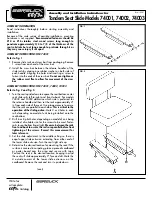
ATTACH ENERGY
ABSORBER
ONLY TO DORSAL
D-RING
MAXIMUM ATTACHMENT DISTANCE
WITH HOOK WITHOUT HOOK
ACCEPTABLE DESIGNED RETAINER
DO NOT
ATTACH ENERGY
ABSORBER
TO ANCHOR
When using lanyards commonly referred to
as "100% tie-off”, "Y" type, "double" or "twin
leg" shock absorbing lanyards. This
supplement provides additional information
on the use of these types of lanyards that are
used with a personal fall arrest systems.
Practices that must be followed in order to
use a 100% tie-off lanyard safely.
1.
The shock absorber pack portion of the
lanyard assembly MUST be connected
to the back dorsal D-ring ONLY, by way
of a double locking lanyard snap hook
(other connectors provided, consult
ULTRA-SAFE, INC.) connect shock
absorber directly to the dorsal D-ring.
2.
Do not connect shock absorber to the
anchorage point at any time.
3.
Do not connect the unused leg of the
lanyard assembly to any portion of the
full body harness, unless a specifically
designed lanyard snap hook loop
retainer is provided for this purpose.
4.
When connecting from one anchorage
point to the next (traversing a vertical or
horizontal structure) do not connect to
an anchorage point further apart than,
the length of the lanyard.
5.
When using a 100% tie-off lanyard
assembly, do not allow any part of the
lanyard to pass under arms or legs.
6.
Connection of both lanyard legs to
separate
anchorage
points
is
acceptable, as long as anchorage
points are within the length of the
lanyard.
2
ANCHORAGE:
Select a rigid anchorage point that is capable of supporting the required loads. The
anchorage location must be carefully selected to reduce possible free fall and swing fall hazards and
to avoid striking an object during a fall. The anchorage should be generally level (horizontal) to prevent
the anchorage connector from sliding down an incline when in use, which could cause serious injury
to the user.
FREE FALL:
Maximum free-fall distance six feet or energy absorber arresting force of 900 lbs per ANSI
or maximum fall arrest force of 1800 lbs per OSHA.
CONNECTING TO ANCHORAGE OR ANCHORAGE
CONNECTOR:
Always connect the energy
absorber end of the lanyard to the body support
(harness). Connect the lanyard end to the
anchorage or anchorage connector. Component
style energy absorbers should be connected to the' body support first, then coupled
to the rest of the system. Some anchorage connector devices may be supplied with
permanently attached energy absorber. Use of an additional energy absorber or
energy absorbing lanyard with these types of subsystems is not recommended.
FALL CLEARANCE:
Should a fall occur, there
must be sufficient clearance in the fall area
to arrest the fall before striking the ground or other object. Energy absorbers can extend the fall
arrest distance by up to 42 inches (106.7 cm). The illustration to the right shows how to estimate
fall clearance distance when using an energy absorbing lanyard or energy absorber subsystem.
Other factors may influence the required clearance distances. For example, using an energy
absorbing lanyard or energy absorber with a rope grab (fall arrestor) may require additional
clearance due to stretch in the lifeline or sliding of the rope grab on the lifeline during fall arrest.
Some full body harness models incorporate a sliding (positional) D-ring in the back as the fall
arrest attachment, movement of this D-ring during fall arrest can increase the fall clearance
distance required. Use caution when assembling system components that could act to extend the
fall arrest distance (and therefore fall clearance required). Refer to manufacturer's instructions
for each part of the system for more information on fall clearance.
Swing Fall
Hazard
Energy
Absorbing
Lanyard
Energy
Absorbing
Lanyard
Connecting
Subsystem
Anchorage
Connector
Anchorage
Connector
Anchorage
Connector
C
H
E
S
T
L
O
O
P
S
A
N
D
Y
-L
A
N
Y
A
R
D
S
Anchor
Point
Nearest
Obstruction
(Lower Level)
NOTE:
Allow a minimum of
17’ from anchor
point to lower level.
Clearance to Obstruction
1 1/2ft (.5m) Min Allowed






















